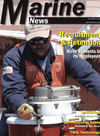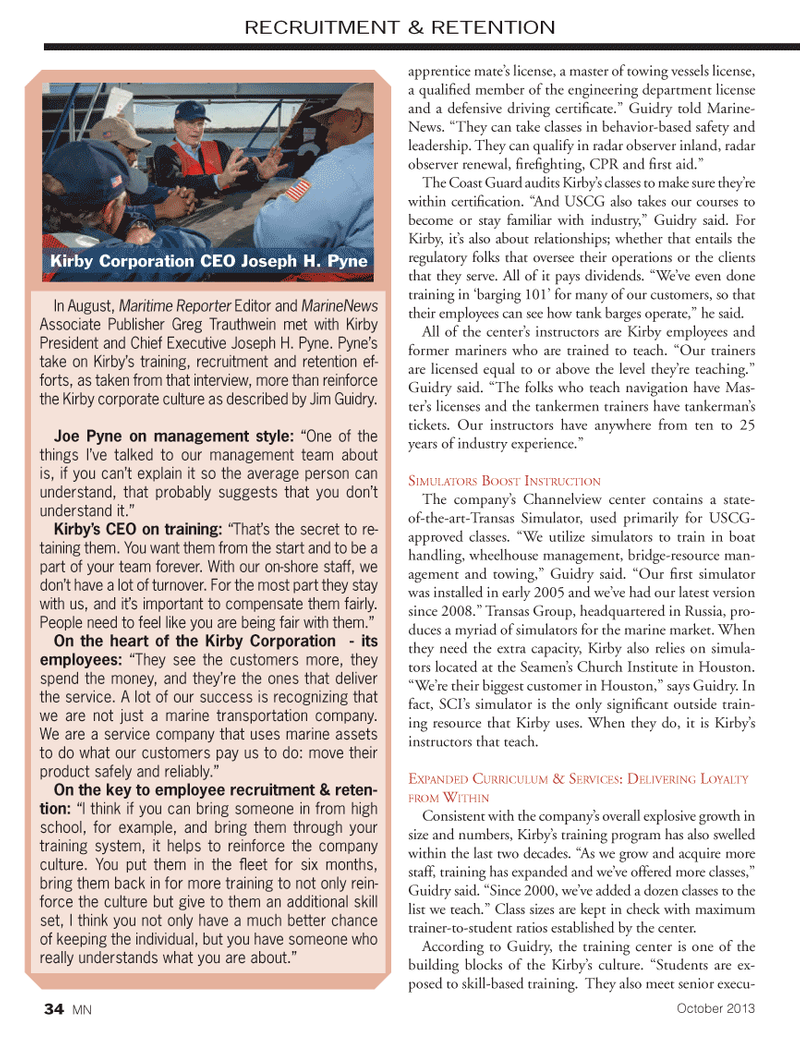
Page 34: of Marine News Magazine (October 2013)
Manning: Recruitment & Retention
Read this page in Pdf, Flash or Html5 edition of October 2013 Marine News Magazine
apprentice mate?s license, a master of towing vessels license, a quali ed member of the engineering department license and a defensive driving certi cate.? Guidry told Marine- News. ?They can take classes in behavior-based safety and leadership. They can qualify in radar observer inland, radar observer renewal, re ghting, CPR and rst aid.? The Coast Guard audits Kirby?s classes to make sure they?re within certi cation. ?And USCG also takes our courses to become or stay familiar with industry,? Guidry said. For Kirby, it?s also about relationships; whether that entails the regulatory folks that oversee their operations or the clients that they serve. All of it pays dividends. ?We?ve even done training in ?barging 101? for many of our customers, so that their employees can see how tank barges operate,? he said. All of the center?s instructors are Kirby employees and former mariners who are trained to teach. ?Our trainers are licensed equal to or above the level they?re teaching.? Guidry said. ?The folks who teach navigation have Mas- ter?s licenses and the tankermen trainers have tankerman?s tickets. Our instructors have anywhere from ten to 25 years of industry experience.? SIMULATORS BOOST INSTRUCTION The company?s Channelview center contains a state- of-the-art-Transas Simulator, used primarily for USCG- approved classes. ?We utilize simulators to train in boat handling, wheelhouse management, bridge-resource man- agement and towing,? Guidry said. ?Our rst simulator was installed in early 2005 and we?ve had our latest version since 2008.? Transas Group, headquartered in Russia, pro- duces a myriad of simulators for the marine market. When they need the extra capacity, Kirby also relies on simula- tors located at the Seamen?s Church Institute in Houston. ?We?re their biggest customer in Houston,? says Guidry. In fact, SCI?s simulator is the only signi cant outside train- ing resource that Kirby uses. When they do, it is Kirby?s instructors that teach. EXPANDED CURRICULUM & SERVICES : DELIVERING LOYALTY FROM WITHINConsistent with the company?s overall explosive growth in size and numbers, Kirby?s training program has also swelled within the last two decades. ?As we grow and acquire more staff, training has expanded and we?ve offered more classes,? Guidry said. ?Since 2000, we?ve added a dozen classes to the list we teach.? Class sizes are kept in check with maximum trainer-to-student ratios established by the center. According to Guidry, the training center is one of the building blocks of the Kirby?s culture. ?Students are ex- posed to skill-based training. They also meet senior execu- RECRUITMENT & RETENTIONIn August, Maritime Reporter Editor and MarineNews Associate Publisher Greg Trauthwein met with Kirby President and Chief Executive Joseph H. Pyne. Pyne?s take on Kirby?s training, recruitment and retention ef- forts, as taken from that interview, more than reinforce the Kirby corporate culture as described by Jim Guidry. Joe Pyne on management style: ?One of the things I?ve talked to our management team about is, if you can?t explain it so the average person can understand, that probably suggests that you don?t understand it.?Kirby?s CEO on training: ?That?s the secret to re- taining them. You want them from the start and to be a part of your team forever. With our on-shore staff, we don?t have a lot of turnover. For the most part they stay with us, and it?s important to compensate them fairly. People need to feel like you are being fair with them.? On the heart of the Kirby Corporation - its employees: ?They see the customers more, they spend the money, and they?re the ones that deliver the service. A lot of our success is recognizing that we are not just a marine transportation company. We are a service company that uses marine assets to do what our customers pay us to do: move their product safely and reliably.? On the key to employee recruitment & reten- tion: ?I think if you can bring someone in from high school, for example, and bring them through your training system, it helps to reinforce the company culture. You put them in the eet for six months, bring them back in for more training to not only rein- force the culture but give to them an additional skill set, I think you not only have a much better chance of keeping the individual, but you have someone who really understands what you are about.? Kirby Corporation CEO Joseph H. PyneOctober 201334 MNMN October2013 Layout 32-49.indd 34MN October2013 Layout 32-49.indd 349/30/2013 11:29:53 AM9/30/2013 11:29:53 AM

 33
33

 35
35
